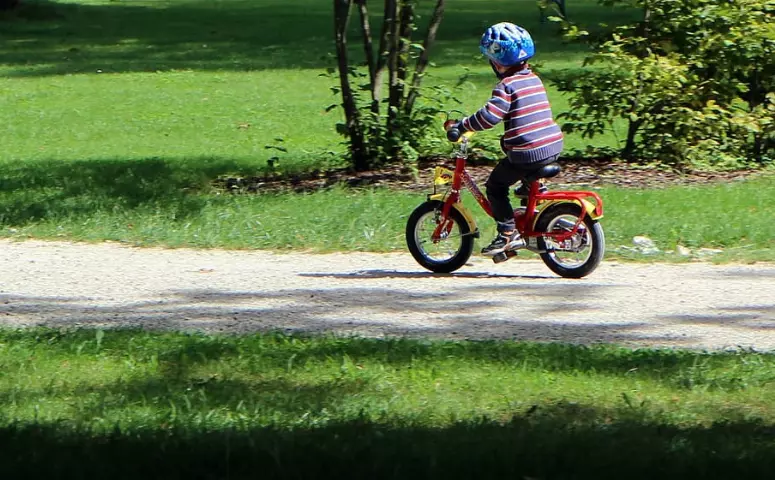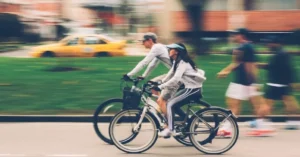It’s never too late to start riding a bicycle. It is no more difficult in adulthood than it was when you were a child. First you need to buy a bike or rent one.
How to learn how to ride a bike well as an adult
First, you need to adjust the bike to fit you. Comfort is everything.
- Adjust the seat height so that you have the ability to touch the ground with your foot when needed. You should sit comfortably. This is the key to success in training and riding.
- Choose the right clothing. It should have a protective function (don’t forget knee protection, elbow protection and a helmet for your head), and be generally comfortable, of course.
- Don’t opt for new clothes. Remember: there’s a good chance you could ruin your attire when riding.
- Select a place for training. The site should have a fairly hard surface, but it is better not to practice bike riding on the asphalt – the injuries could be unpleasant.
The first exercise is simply to walk next to the bike. Control it and stop it with the brakes. Then you’ll have to learn to get on the bike correctly. Stand to the left of the bike and grab the brakes with both hands. Then tilt the bike, put your right foot on the other side and sit down comfortably. Get off by repeating all these steps in reverse order. Might sound too simple to think about, but riding a bike must become something fully automatic to your brain – like walking.
Continue with balance: keep one foot on the ground and the other on the pedal. Push off the ground with your foot and try to propel yourself forward. The other leg should be relaxed at this time. Do not lean to the side, try to ride farther away and keep your balance using your body, not the handlebars. Remember that your eyes should be looking forward and your body should be turned slightly toward the tilt of the handlebars.
One common question is how to take off properly when riding a bike. Begin your ride as follows:
- Sit comfortably on your bike.
- Don’t get tense, try to relax your muscles.
- Your weight should be distributed evenly over your two arms and two legs.
- Don’t make your start too sharp, go slowly and smoothly.
- Balance is not only about proper distribution of the weight between all your arms and legs, but also about your vision. Look straight ahead and set yourself up for balance.
- Learn to ride only on straight terrain at first. Turn the handlebars slightly and tilt your body just a little bit to the side of the roll.
- Forget about riding fast at the beginning of your training, but slow riding will not help you learn either. Your job is to keep your balance, ride straight and keep a medium pace.
If you feel the need for outside help, ask a friend to assist you. Another option is to take a few lessons from an instructor. Once you learn to ride straight, make it harder and add turns to your training.

How a child can learn to ride a bicycle
From the first years of life, kids may start riding on specialized vehicles. It is natural to start with toddler bikes, tricycles, or scooters. It is best to start accustoming your kid to a toddler bike when he or she is about one year old – this way you’ll have it easier with teaching the baby to keep balance. Later the child will learn to ride a real bicycle much faster. A bicycle with a higher seat can be used from the age of one and a half to two years.
The suitable time for the beginning of training with a real bike is when the kid is three years old. It can be a bicycle with additional wheels for holding the balance, which can later be removed. Tips on how to teach a child to ride a bicycle are as follows:
- Start teaching your child to ride a bike by choosing the right bike for the child’s age, height and body weight. Do not buy a larger bike intended for later use – it will only complicate the training.
- Afterwards, adjust the bike to your kid to make it more comfortable. Check the brakes and other parts of the bike so that they function properly.
- Take care of protective gear: knee pads, elbow pads and a helmet should always protect your child’s vulnerable parts.
- Choose comfortable, second-hand or otherwise unimportant clothing that would cover the legs and arms. Shoes should have a textured sole to provide good traction on pedals. Choose closed-toe models of athletic shoes.
- Find a good road, an area without obvious risks and with a rather flat surface.
- Do not force your child to ride. The main key to success is the kid’s desire. Put him or her on a bicycle without pedals first, and make sure their feet reach the ground.
- Teach the kid to ride up a hill first and then down it. To stay on the bike, he or she will constantly try to push off the ground, or brake against it with their feet. Remind your kid about keeping the handlebars straight and always looking forward.
- Attach the pedals and let your child stand on the bike, put their feet on the pedals and feel the balance.
Conclusion
The ability to ride a bicycle has always been at least a fanciful activity, and at most a rewarding exercise as well. Nowadays, it is an important skill for people in both urban and rural areas. The modern world is becoming more and more bike-friendly. So learn to ride them yourself – it’s never too late, and teach your kids – they’ll benefit from it.
Understandably, some people only need a bike occasionally. In larger cities it is easier to rent one. To be able to ride around the Big Apple, for example, just visit a reputable bike rental in NYC. It’s the place that both New Yorkers and visitors of the city turn to when they need a bike for a while – the quality of service there is on the highest level.
